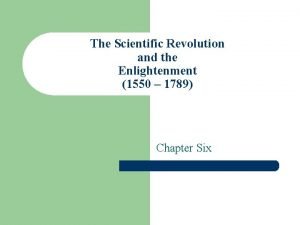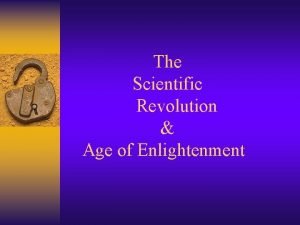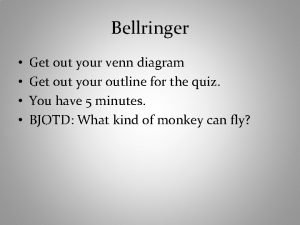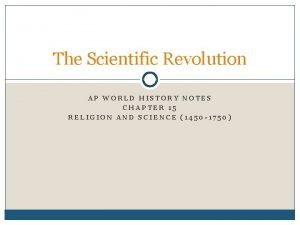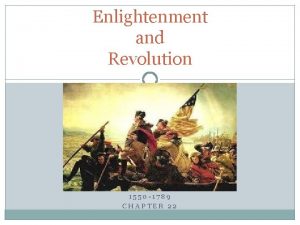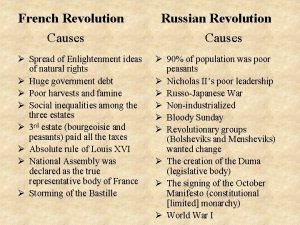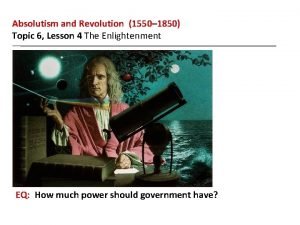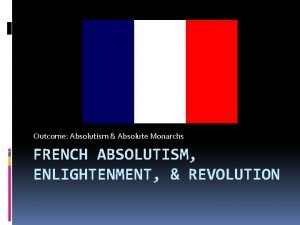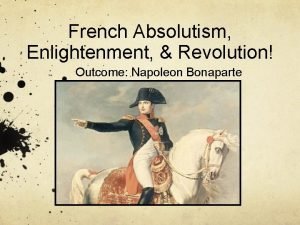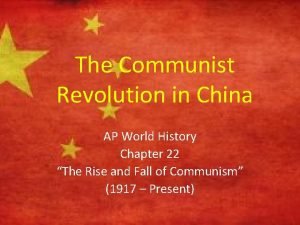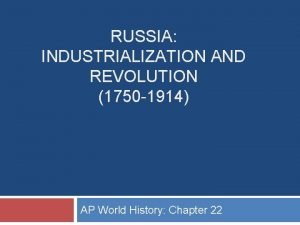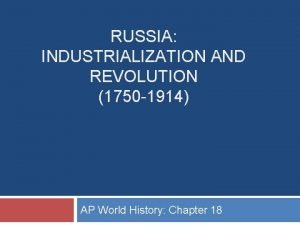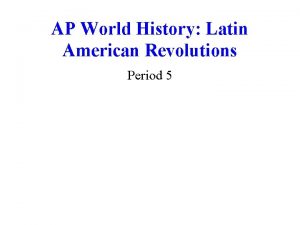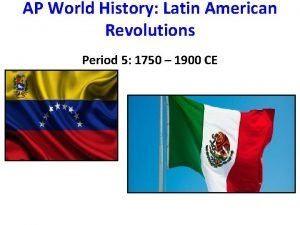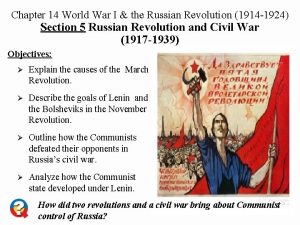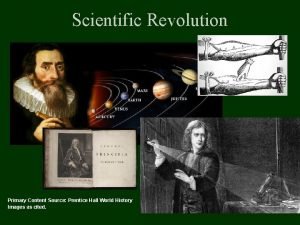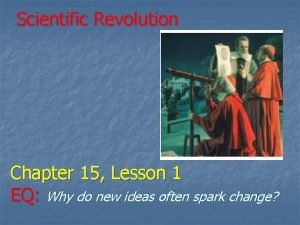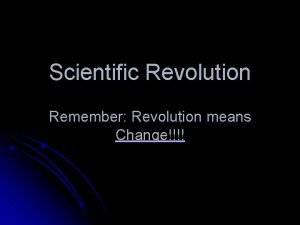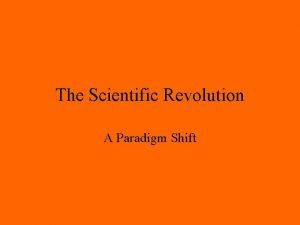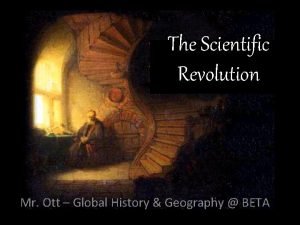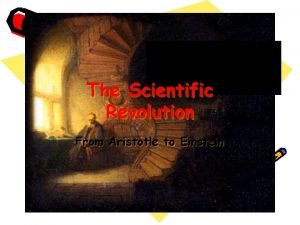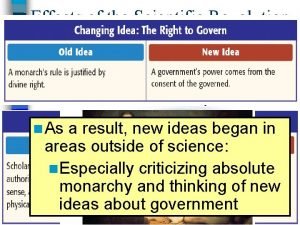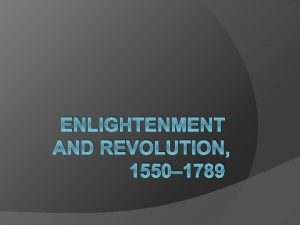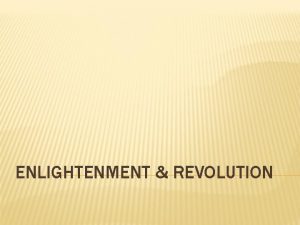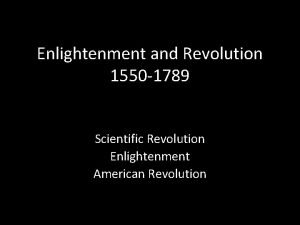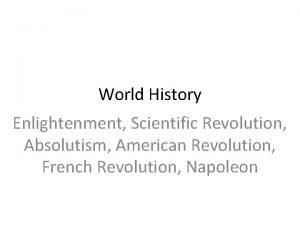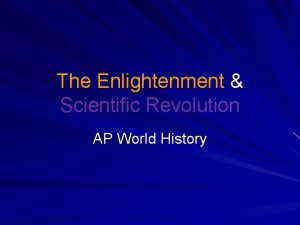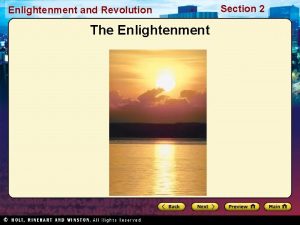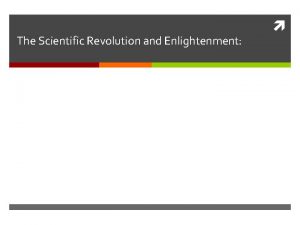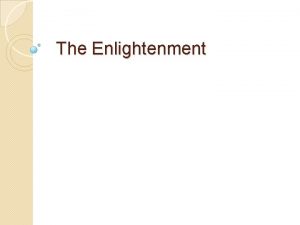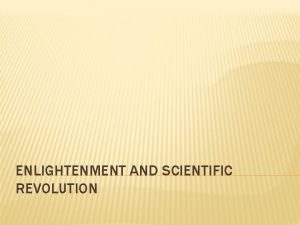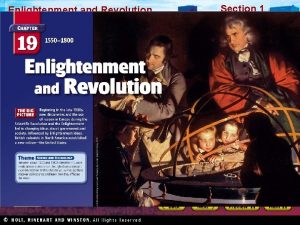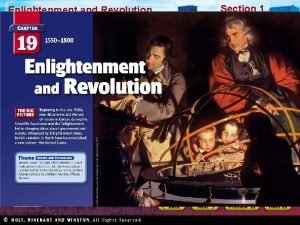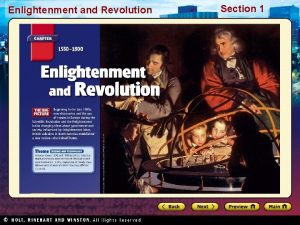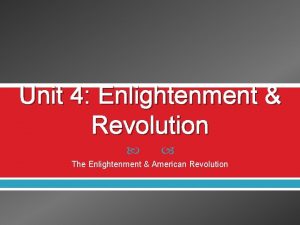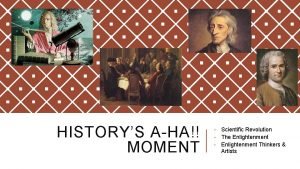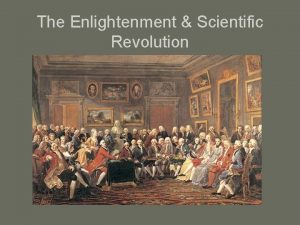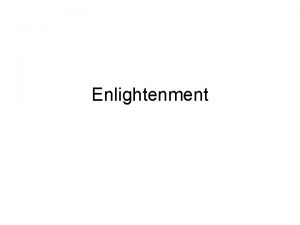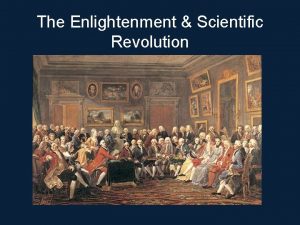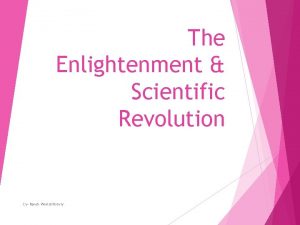Chapter 10 Scientific Revolution Enlightenment World History Of








































- Slides: 40

Chapter 10 Scientific Revolution & Enlightenment World History

• Of all the changes that swept over Europe in the seventeenth and eighteenth centuries, the most widely influential was an epistemological transformation that we call the "Scientific Revolution. " In the popular mind, we associate this revolution with natural science and technological change, but the scientific revolution was, in reality, a series of changes in the structure of European thought itself: systematic doubt, empirical and sensory verification, the abstraction of human knowledge into separate sciences, and the view that the world functions like a machine. • These changes greatly changed the human experience of every other aspect of life, from individual life to the life of the group. This modification in world view can also be charted in painting, sculpture and architecture; you can see that people of the seventeenth and eighteenth centuries are looking at the world very differently.

Ptolemy (85? -165? ) • He believed that the Earth was the center of the universe. • He was the greatest astronomer of antiquity. • Using his ideas philosophers of the Middle Ages constructed a model of the universe known later as the Ptolemaic system. Ptolemy

Ptolemy (85? -165? ) • He was an eminent astronomer, mathematician, and geographer who lived in the 2 nd century AD. Although his work has survived, almost nothing is known about his life. Ptolemy published his astronomical data in an encyclopedic volume known as 'Almagest'. It synthesized Greek astronomical knowledge and provided an expanded catalog of 1, 022 stars. He proposed a geocentric, or Earth-centered, universe in which the planets and fixed stars were embedded in concentric crystalline spheres that revolved around the Earth. Outside the spheres of fixed stars were other spheres, ending with the "prime mover, " which provided the motive power for all the spheres. The Ptolemaic system was the official dogma of Western Christendom until the 1500 s, when it was replaced by Nicolaus Copernicus's heliocentric, or Sun-centered, system (see Copernicus). • Ptolemy published several books on new geometrical proofs and theorems, prepared a calendar that gave weather indications and the rising and setting of stars, wrote five books on optical phenomena, and developed a three-book treatise on music. His reputation as a geographer rests on his eight-volume work Guide to Geography. The books provide information on mapmaking and list places in Europe, Asia, and Africa by latitude and longitude. In spite of its many errors this work greatly influenced succeeding generations of geographers and mapmakers.

Geocentric • What the Ptolemaic system was called because it places Earth at the center of the universe.

Ptolemaic System • The universe is a series of concentric spheres— spheres one inside the other. Earth is fixed, or motionless, at the center of these spheres.

Nicholas Copernicus (1473 -1543) Nicholas Copernicus • Polish astronomer who is considered to be the founder of modern astronomy. • He authored On the Revolutions of the Heavenly Spheres (1543) where he believed in the heliocentric theory conception of the universe.

Nicholas Copernicus (1473 -1543) • Polish astronomer, considered the founder of modern astronomy. On the basis of his observations and calculations, he advanced then revolutionary idea that the earth rotated on its axis and that the planets, including the earth, revolved around the sun (the Copernican system). Educated in astronomy at the University of Krakow, he was appointed (1497) canon of the cathedral at Frauenburg, East Prussia. In subsequent years he began to develop his heliocentric theory, opposing the traditional, earth-centered theory. By 1530, he had largely completed his book on theory, On the Revolutions of the Celestial Spheres (De revolutionibus orbium coelestium), but delayed the start of publication until 1540. He is said to have received the first bound copy just before his death (1543).

Heliocentric • Sun-centered conception of the universe. • The sun is at the center and the planets revolve around the sun.

Johannes Kepler (1571 -1630) • German mathematician who used astronomical data to arrive at his laws of planetary motion. • Kepler showed that the orbits of the planets around the Sun were not circular, as Copernicus had thought. The orbits were elliptical (eggshaped), with the Sun toward the end of the ellipse instead of the center. Johannes Kepler

Kepler’s Elliptical Orbits

Johannes Kepler (1571 -1630) • Johannes Kepler was born in Weil der Stadt in Swabia, in southwest Germany. His paternal grandfather, Sebald Kepler, was a respected craftsman who served as mayor of the city; his maternal grandfather, Melchior Guldenmann, was an innkeeper and mayor of the nearby village of Eltingen. His father, Heinrich Kepler, was "an immoral, rough and quarrelsome soldier, " according to Kepler, and he described his mother in similar unflattering terms. From 1574 to 1576 Johannes lived with his grandparents; in 1576 his parents moved to nearby Leonberg, where Johannes entered the Latin school. In 1584 he entered the Protestant seminary at Adelberg, and in 1589 he began his university education at the Protestant university of Tübingen. Here he studied theology and read widely. He passed the M. A. examination in 1591 and continued his studies as a graduate student. Kepler's teacher in the mathematical subjects was Michael Maestlin (1550 -1635). Maestlin was one of the earliest astronomers to subscribe to Copernicus's heliocentric theory, although in his university lectures he taught only the Ptolemaic system. Only in what we might call graduate seminars did he acquaint his students, among whom was Kepler, with the technical details of the Copernican system. Kepler stated later that at this time he became a Copernican for "physical or, if you prefer, metaphysical reasons. " In 1594 Kepler accepted an appointment as professor of mathematics at the Protestant seminary in Graz (in the Austrian province of Styria). He was also appointed district mathematician and calendar maker. Kepler remained in Graz until 1600, when all Protestants were forced to convert to Catholicism or leave the province, as part of Counter Reformation measures. For six years, Kepler taught arithmetic, geometry (when there were interested students), Virgil, and rhetoric. In his spare time he pursued his private studies in astronomy and astrology. In 1597 Kepler married Barbara Müller. In that same year he published his first important work, The Cosmographic Mystery, in which he argued that the distances of the planets from the Sun in the Copernican system were determined by the five regular solids, if one supposed that a planet's orbit was circumscribed about one solid and inscribed in another. Except for Mercury, Kepler's construction produced remarkably accurate results. Because of his talent as a mathematician, displayed in this volume, Kepler was invited by Tycho Brahe to Prague to become his assistant and calculate new orbits for the planets from Tycho's observations. Kepler moved to Prague in 1600. Kepler served as Tycho Brahe's assistant until the latter's death in 1601 and was then appointed Tycho's successor as Imperial Mathematician, the most prestigious appointment in mathematics in Europe. He occupied this post until, in 1612, Emperor Rudolph II was deposed. In Prague Kepler published a number of important books. In 1604 Astronomia pars Optica ("The Optical Part of Astronomy") appeared, in which he treated atmospheric refraction but also treated lenses and gave the modern explanation of the workings of the eye; in 1606 he published De Stella Nova ("Concerning the New Star") on the new star that had appeared in 1604; and in 1609 his. Astronomia Nova ("New Astronomy") appeared, which contained his first two laws (planets move in elliptical orbits with the sun as one of the foci, and a planet sweeps out equal areas in equal times). Whereas other astronomers still followed the ancient precept that the study of the planets is a problem only in kinematics, Kepler took an openly dynamic approach, introducing physics into the heavens. In 1610 Kepler heard and read about Galileo's discoveries with the spyglass. He quickly composed a long letter of support which he published as. Dissertatio cum Nuncio Sidereo ("Conversation with the Sidereal Messenger"), and when, later that year, he obtained the use of a suitable telescope, he published his observations of Jupiter's satellites under the title Narratio de Observatis Quatuor Jovis Satellitibus ("Narration about Four Satellites of Jupiter observed"). These tracts were an enormous support to Galileo, whose discoveries were doubted or denied by many. Both of Kepler's tracts were quickly reprinted in Florence. Kepler went on to provide the beginning of a theory of the telescope in his Dioptrice, published in 1611. During this period the Keplers had three children (two had been born in Graz but died within months), Susanna (1602), who married Kepler's assistant Jakob Bartsch in 1630, Friedrich (1604 -1611), and Ludwig (1607 -1663). Kepler's wife, Barbara, died in 1612. In that year Kepler accepted the position of district mathematician in the city of Linz, a position he occupied until 1626. In Linz Kepler married Susanna Reuttinger. The couple had six children, of whom three died very early. In Linz Kepler published first a work on chronology and the year of Jesus's birth, In German in 1613 and more amply in Latin in 1614: De Vero Anno quo Aeternus Dei Filius Humanam Naturam in Utero Benedictae Virginis Mariae Assumpsit (Concerning the True Year in which the Son of God assumed a Human Nature in the Uterus of the Blessed Virgin Mary"). In this work Kepler demonstrated that the Christian calendar was in error by five years, and that Jesus had been born in 4 BC, a conclusion that is now universally accepted. Between 1617 and 1621 Kepler published Epitome Astronomiae Copernicanae ("Epitome of Copernican Astronomy"), which became the most influential introduction to heliocentric astronomy; in 1619 he published Harmonice Mundi ("Harmony of the World"), in which he derived the heliocentric distances of the planets and their periods from considerations of musical harmony. In this work we find his third law, relating the periods of the planets to their mean orbital radii. In 1615 -16 there was a witch hunt in Kepler's native region, and his own mother was accused of being a witch. It was not until late in 1620 that the proceedings against her ended with her being set free. At her trial, her defense was conducted by her son Johannes. 1618 marked the beginning of the Thirty Years War, a war that devastated the German and Austrian region. Kepler's position in Linz now became progressively worse, as Counter Reformation measures put pressure on Protestants in the Upper Austria province of which Linz was the capital. Because he was a court official, Kepler was exempted from a decree that banished all Protestants from the province, but he nevertheless suffered persecution. During this time Kepler was having his Tabulae Rudolphinae("Rudolphine Tables") printed, the new tables, based on Tycho Brahe's accurate observations, calculated according to Kepler's elliptical astronomy. When a peasant rebellion broke out and Linz was besieged, a fire destroyed the printer's house and shop, and with it much of the printed edition. Soldiers were garrisoned in Kepler's house. He and his family left Linz in 1626. The Tabulae Rudolphinae were published in Ulm in 1627. Kepler now had no position and no salary. He tried to obtain appointments from various courts and returned to Prague in an effort to pry salary that was owed him from his years as Imperial Mathematician from the imperial treasury. He died in Regensburg in 1630. Besides the works mentioned here, Kepler published numerous smaller works on a variety of subjects.

Galileo Galilei (1564 -1642) • Italian scientist and mathematician who discovered that the planets were made of matter. • He was the first European to make regular observations with a telescope. He saw mountains on the Moon and the four moons orbiting Jupiter. Galileo Galilei

Galileo Galilei (1564 -1642) • Galileo’s work began to make Europeans aware of the new view of the universe. • He got into trouble with the Catholic Church, which ordered him to abandon the new system because the Copernican conception contradicted that of the Church and the Bible. • In the Copernican system the heavens were not spiritual but material, and God was no longer in a specific place.

Galileo Galilei (1564 -1642) • Galileo was born on February 15, 1564 in Pisa. By the time he died on January 8, 1642 (but see problems with the date, Machamer 1998, pp. 24– 5) he was as famous as any person in Europe. Moreover, when he was born there was no such thing as ‘science’, yet by the time he died science was well on its way to becoming a discipline and its concepts and method a whole philosophical system. Galileo and his family moved to Florence in 1572. He started to study for the priesthood, but left and enrolled for a medical degree at the University of Pisa. He never completed this degree, but instead studied mathematics notably with Ostilio Ricci, the mathematician of the Tuscan court. Later he visited the mathematician Christopher Clavius in Rome and started a correspondence with Guildobaldo del Monte. He applied and was turned down for a position in Bologna, but a few years later in 1589, with the help of Clavius and del Monte, he was appointed to the chair of mathematics in Pisa. In 1592 he was appointed, at a much higher salary, to the position of mathematician at the University of Padua. While in Padua he met Marina Gamba, and in 1600 their daughter Virginia was born. In 1601 they had another daughter Livia, and in 1606 a son Vincenzo. It was during his Paduan period that Galileo worked out much of his mechanics and began his work with the telescope. In 1610 he published The Starry Messenger, and soon after accepted a position as Mathematician and Philosopher to the Grand Duke of Tuscany (and a non-teaching professorship at Pisa). He had worked hard for this position and even named the moons of Jupiter after the Medici. There were many reasons for his move but he says he did not like the wine in the Venice area and he had to teach too many students. Late in 1610, the Collegio Romano in Rome, where Clavius taught, certified the results of Galileo's telescopic observations. In 1611 he became a member of what is perhaps the first scientific society, the Academia dei Lincei. In 1612 Galileo published a Discourse on Floating Bodies, and in 1613, Letters on the Sunspots. In this latter work he first expressed his position in favor of Copernicus. In 1614 both his daughters entered the Franciscan convent of Saint Mathew, near Florence. Virginia became Sister Maria Celeste and Livia, Sister Arcangela. Marina Gamba, their mother, had been left behind in Padua when Galileo moved to Florence. In 1613– 14 Galileo entered into discussions of Copernicanism through his student Benedetto Castelli, and wrote a Letter to Castelli. In 1616 he transformed this into the Letter to the Grand Duchess Christina. In February 1616, the Scared Congregation of the Index condemned Copernicus' book On the Revolution of the Heavenly Orbs, pending correction. Galileo then was called to an audience with Cardinal Robert Bellarmine and advised not to teach or defend Copernican theory. In 1623 Galileo published The Assayer dealing with the comets and arguing they were sublunary phenomena. In this book, he made some of his most famous methodological pronouncements including the claim the book of nature is written in the language of mathematics. The same year Maffeo Barberini, Galileo's supporter and friend, was elected Pope Urban VIII. Galileo felt empowered to begin work on his Dialogues concerning the Two Great World Systems. It was published with an imprimatur from Florence (and not Rome) in 1632. Shortly afterwards the Inquisition banned its sale, and Galileo was ordered to Rome for trial. In 1633 he was condemned. In 1634, while Galileo was under house arrest, his daughter, Maria Celeste died. (Cf. Sobel 1999). At this time he began work on his final book, Discourses and Mathematical Demonstrations concerning Two New Sciences. This book was smuggled out of Italy and published in Holland. Galileo died early in 1642. Due to his conviction, he was buried obscurely until 1737.

The Starry Messenger (1610) • Book authored by Galileo where he published his ideas and discoveries.

Isaac Newton (1642 -1727) • English mathematician and physicist who taught at the University of Cambridge. • He is famous for his discoveries in developing calculus, law of gravitation, and his three laws of motion. Isaac Newton

Principia (Mathematical Principles of Natural Philosophy) (1687) • Book written by Isaac Newton where he defined the three laws of motion that govern the planetary bodies, as well as objects on Earth. He also wrote of the universal law of gravitation.

Universal Law of Gravitation • Discovered by Isaac Newton, it explains that planetary bodies do not go off in straight lines but instead continue in elliptical orbits about the sun because every object in the universe is attracted to every other object by a force called gravity.

Andreas Vesalius (1514 -1564) Andreas Vesalius • He brought forth the new human anatomy of the 16 th century. • He reported his results from dissecting human bodies as a professor of surgery at the University of Padua (in Italy). • He presented an accurate view of the individual organs and general structure of the human body. However, he erroneously believed that the body had two kinds of blood.

Andreas Vesalius (1514 -1564) • Like many other Renaissance physicians and artists, Andreas Vesalius was driven by a desire to know the human body in all its parts and aspects. An irresistible urge to dissect had mastered him even as a child, periodically leaving in its wake a succession of dismembered neighborhood dogs, cats, mice, and moles that had succumbed to his curiosity. The son of a court apothecary, Vesalius was born in Brussels, and sent to Paris to study medicine. Once there, however, he was greatly disappointed to find that his anatomy teachers were content to expound on Galen while poking around in the bodies of dead dogs. Having reappeared at the beginning of the fourteenth century in Bologna, the practice of dissecting human bodies was spreading; more and more authorities began placing the corpses of executed criminals at the disposal of universities. Searching for more rigorous training in anatomy, Vesalius left Paris and returned to Brussels, where, risking imprisonment, he stole a body from the gallows to acquire a complete human skeleton. Next, Vesalius moved on to the University of Padua, where he received his medical degree in 1537 and was appointed professor of surgery and anatomy. Here, as elsewhere, anatomical demonstrations were highly ritualized events, with the professor seated above the corpse reading from a Galenic text, the surgeon dissecting, and the demonstrator pointing to the indicated parts of the body. Not content with this division of labor, Vesalius took scalpel in hand, with the result that he soon proved many of Galen’s centuries-old observations to be false. Because it was still unthinkable to dispute Galen’s claims, however, discrepancies between what was seen in the sixteenth-century corpse and what was written in the second-century text were ascribed to the "fact" that the human body had changed since antiquity. Vesalius offered another explanation: He was certain that Galen, in most cases, had dissected not human bodies but those of monkeys, goats, and pigs. Setting out to portray a true picture of the human anatomy, Vesalius published the results of his anatomical work in De Humanis Corporis Fabrica, Libri Septem (1543), one of the most important of the early generation of printed books. Containing 663 folio pages and more than three hundred illustrations by the painter Jan Stefan von Kalkar, the great treatise appeared in the same year that Copernicus redrew the anatomy of the heavens.

On The Fabric of the Human Body (1543) • Book written by Andreas Vesalius where he reported his results from dissecting human bodies.

William Harvey (1578 -1657) • English physician and scientist who described the circulation of blood in the human body. • He showed that the heart was the origin of the blood’s circulation, that the same blood runs through veins and arteries, and that the blood makes a complete circuit through the body. • He later proposed that all animals originate from an ovum produced by the female of the species. • His work was based on close observation and experiment. William Harvey

On the Motion of the Heart and Blood (1628) • Book written by William Harvey were he expressed his discoveries and observations about the circulation of blood in the human body.

Robert Boyle (1627 -1691) • English scientist who used close observation and experiment in chemistry. • He formulated Boyle’s Law about gases. Robert Boyle

Robert Boyle (1627 -1691) • Robert Boyle was born in Ireland, in 1627, even though he was raise in England. Boyle was the youngest of fourteen children. His father was the wealthiest man of the British Isles. Boyle studied at the world famous Eton College for four years and then he later traveled Europe. He never really attended a university but he did live at Oxford for a long time. During his six-year trip, Boyle learned all about science and medicine not excluding other important subjects as philosophy, mathematics and religion. Boyle never married and lived most of his life with his sister Katherine and was later buried next to her, when he died in 1691. Robert Boyle was known as a natural philosopher and a chemist. Boyle is known as the father of modern Chemistry. He did a lot of work with air properties. He did many tests on the relationships between air pressure and air volume. He eventually came to the result that with more pressure, air would take up less volume. That sounds really simple today but in his time this was a great discovery. This law was later to be called Boyle’s Law. Many scientists think that the law shouldn’t be called Boyle’s Law because of Robert Hooke assisted Boyle on his air experiments; well actually he did most of the work so many people think it should be named after Hooke. Boyle also did test on sound air pressure. He wanted to see if sound exists in a vacuum. So he created an air pump that was small enough to be operated by one person. Air pumps and vacuums were not the only things Boyle played with. He also did experiments with elements. In one of Boyle’s most famous books The Skeptical Chemist, Boyle talks about how Aristotle is wrong about the elements. Aristotle believes that there were only four elements, earth wind, fire, and water. Boyle tried to prove that things can be broken down into smaller and many more elements. This was a big deal because Aristotle is a well-known person back in this time. This would be like telling a noble prizewinner that he was all wrong. Robert Boyle was a member and one of the founding fathers of the Royal Society. The Royal Society was a group of the smartest scientist, mathematicians, philosophers, and physicians. They could be called the first research group. They would have weekly meetings at Oxford U. and discuss their current works and share advice with each other. They also performed experiments with each other. The Royal society is still around today and is the most renowned science group in the world. If the government wants to know why something is happening in the world that involves science they go to the Royal Society. The Royal Society motto was "Nullius in Verbal, " which means nothing in writing. They thought that all science should be done with experiments. All science students have to thank Robert Boyle because he began the whole deal with making exact measurements, making sure there is a control group, and doing a experiment many times to make sure it is correct. Without Boyle figuring out that all these factors were very important, many experiments could have produced false data. Boyle’s work is very important to me because without it we could have not figured out that volume is related to pressure. Scuba diving is directly related to Boyle’s Law, so without him scuba diving could have been put off to the next century. His work is also very important because the understanding of precise measurements. My medication could have been in too large a dose without precise measurements. I know Boyle is not the most exciting scientist but he is very important. He laid the framework for most chemists.

Boyle’s Law • It was discovered by Robert Boyle. • States that the volume of gas varies with the pressure exerted on it.

Antoine Lavoisier (1743 -1794) • He is regarded as the founder of modern chemistry. • Lavoisier carefully measured the weights of substances involved in chemical reactions. In 1772, he began a series of experiments that demonstrated the nature of combustion (burning). He concluded that combustion results from the rapid chemical union of a flammable material with a newly discovered gas, which he called oxygen. • Lavoisier also found that the weight of the products of combustion equals the weight of the reacting ingredients. This observation became known as the law of conservation of mass (or matter). • He also invented a system of naming the chemical elements.

Antoine Lavoisier (1743 -1794) • • Antoine Lavoisier was a French chemist. He is regarded as the founder of modern chemistry. Lavoisier carefully measured the weights of substances involved in chemical reactions. In 1772, he began a series of experiments that demonstrated the nature of combustion (burning). He concluded that combustion results from the rapid chemical union of a flammable material with a newly discovered gas, which he called oxygen. Lavoisier also found that the weight of the products of combustion equals the weight of the reacting ingredients. This observation became known as the law of conservation of mass (or matter). Lavoisier published his findings in his Elementary Treatise on Chemistry (1789), which is considered the first modern textbook on chemistry. With French astronomer and mathematician Pierre Simon Laplace, Lavoisier conducted experiments on respiration in animals. Their studies demonstrated a similarity between common chemical reactions and the processes that occur in living organisms. These experiments provided the foundation for the science now known as biochemistry. Lavoisier also helped develop a system for naming chemical substances based on their composition. This system is still in use. Antoine Lavoisier was, amongst other things, a chemist, economist, and public servant. He is most noted for his discovery of the role oxygen plays in combustion. Lavoisier, the son of a very prosperous lawyer, was born in Paris on August 26, 1743. He was educated at the College des Quatre Nations where he studied a broad range of academics. He was expected to follow in his fathers footsteps and even obtained his licence to practice law in 1764 before turning to a life of science. In particular, he turned to geology. From 1763 to 1767 he studied geology under Jean Etienne Guettard. In 1765 he wrote and published a paper on how to improve the street lighting in Paris. For this and some works on agriculture, he was elected into the Royal Academy of Science in 1768. Also in this year, he joined the Farmer's General, a private company that collected taxes and tariffs for the government. In 1771, he married the daughter of a Farmer General, Jaques Paulze. She immediately became her husbands collaborator, learning to read English (which Lavoisier could not do) and becoming a skilled draftsman and engraver. In 1775, Lavoisier was appointed to the National Gunpowder Commission. He then moved to the Arsenal of Paris where he created a superb laboratory for his growing experimentation. In large part, he was able to afford his experiments and such a laboratory because of his inherited wealth. His new home quickly became a gathering place for scientists and freethinkers. Lavoisier was politically liberal and shared many of the ideas of the philosophes. He was deeply persuaded of the need for social reform in France. Because of this, he played an active part in the events preceding the French Revolution. He served on a committee concerned with the social conditions of France and proposed tax reforms and new economic strategies. He also served on a committee that explored hospitals and prisons of Paris and then recommended remedies for their horrible state. During the revolution, he published a report on the state of France's finances. When the Estate's General reconvened in 1789, he became an alternate deputy and drew up a code of instructions for the other deputies to follow. Soon after the revolution began, Jean-Paul Marat and other radical journalists began to slander Lavoisier for being a member of the Farmer's General. On May 8 th, 1794, all of the Farmer's General were arrested and thrown in prison. In a trial that lasted less than a day, they were all convicted and sentenced to execution. When Lavoisier requested time to complete some scientific work, the presiding judge was said to have answered "The Republic has no need of scientists. " His body was thrown into a common grave.

Elementary Treatise on Chemistry (1789) • Written by Antoine Lavoisier where he published his scientific findings. • It is considered the first modern textbook on chemistry. Antoine Lavoisier

Margaret Cavendish (1623 -1673) • One of the most prominent female scientists of the 17 th century. • She criticized the belief that humans, through science, were the masters of nature. Margaret Cavendish

Observations Upon Experimental Philosophy (1666) • Book written by Margaret Cavendish where she expressed her ideas. Margaret Cavendish

Maria Winkelmann (1670 -1720) Maria Winkelmann • She was the most famous female German astronomer. • She assisted her husband, the famous Prussian astronomer Gottfried Kirch, and discovered a comet. • Winkelmann was denied a post as assistant astronomer at the Berlin Academy because of her gender.

Rene Descartes (1596 -1650) • A French philosopher, mathematician, and scientist. • He is often called the “father of modern philosophy. ” • He believed that truth is reached through reason. • He also invented analytic geometry. Rene Descartes

Rene Descartes (1596 -1650) • Rene Descartes was a French philosopher, mathematician, and scientist. He is often called the father of modern philosophy. Descartes invented analytic geometry and developed a detailed account of the physical universe in terms of matter and motion. He was a pioneer in the attempt to formulate simple, universal laws of motion that govern all physical change. Descartes wrote three major works. The first was Discourse on the Method of Rightly Conducting One's Reason, and Seeking Truth in the Sciences (1637), commonly known as the Discourse on Method. The others were Meditations on First Philosophy (1641), perhaps his most important work, and Principles of Philosophy (1644). His philosophy became known as Cartesianism. His life. Descartes was born at La Haye, near Chatellerault, and was educated at a Jesuit college. He served in the armies of two countries and traveled widely. Money from an inheritance and from patrons enabled him to devote most of his life to study. From 1628 to 1649, Descartes led a quiet, scholarly life in the Netherlands and produced most of his philosophical writings. Late in 1649, he accepted an invitation from Queen Christina to visit Sweden. He became ill there and died in February 1650. His philosophy. Descartes is called a dualist because he claimed that the world consists of two basic substances--matter and spirit. Matter is the physical universe, of which our bodies are a part. The human mind, or spirit, interacts with the body but can, in principle, exist without it. Descartes believed that matter could be understood through certain simple concepts he borrowed from geometry, together with his laws of motion. In Descartes's view, the whole world--including its laws and even the truths of mathematics--was created by God, on whose power everything depends. Descartes thought of God as resembling the human mind in that both God and the mind think but have no physical being. But he believed God is unlike the mind in that God is infinite and does not depend for His existence on some other creator. In Meditations on First Philosophy, Descartes first considered the strongest reasons that might be used to show that he could never be certain of anything. These so-called "skeptical" arguments included the idea that perhaps he might be dreaming, so that nothing he seemed to perceive would be real. In another argument, Descartes reflected that perhaps God or some evil spirit was constantly tricking his mind, causing him to believe what was false. Descartes then responded to these arguments. He began with the observation that even if he were dreaming, or constantly deceived, he could at least be certain that he had thoughts, and therefore existed as a thinking being. This, he wrote, was a "clear and distinct" perception of the mind. Nothing could make him doubt it. In another work, Descartes introduced the famous Latin phrase cogito ergo sum, which means I think, therefore I am. Descartes then argued that he could also clearly and distinctly perceive that an infinitely powerful and good God exists. This God would not allow Descartes to be deceived in his clearest perceptions. Through this conception of God, Descartes sought to establish that the physical world exists with the properties the philosopher assumed in his physics. He continued to hold, however, that sensory appearances are often misleading.

Discourse on Method (1637) • Book written by Rene Descartes where he developed the philosophy that truth is reached through reason. • His main principle was “I think, therefore I am. ”

Francis Bacon (1561 -1626) • He was a British philosopher who applied scientific thought to philosophy. • He felt that scientists should use inductive reasoning to learn about nature. • He also believed that truth only comes from using the scientific method. • He stressed that systematic and carefully organized experiments would lead to correct general principles. Francis Bacon

Francis Bacon (1561 -1526) • Sir Francis Bacon (later Lord Verulam and the Viscount St. Albans) was an English lawyer, statesman, essayist, historian, intellectual reformer, philosopher, and champion of modern science. Early in his career he claimed “all knowledge as his province” and afterwards dedicated himself to a wholesale revaluation and restructuring of traditional learning. To take the place of the established tradition (a miscellany of Scholasticism, humanism, and natural magic), he proposed an entirely new system based on empirical and inductive principles and the active development of new arts and inventions, a system whose ultimate goal would be the production of practical knowledge for “the use and benefit of men” and the relief of the human condition. At the same time that he was founding and promoting this new project for the advancement of learning, Bacon was also moving up the ladder of state service. His career aspirations had been largely disappointed under Elizabeth I, but with the ascension of James his political fortunes rose. Knighted in 1603, he was then steadily promoted to a series of offices, including Solicitor General (1607), Attorney General (1613), and eventually Lord Chancellor (1618). While serving as Chancellor, he was indicted on charges of bribery and forced to leave public office. He then retired to his estate where he devoted himself full time to his continuing literary, scientific, and philosophical work. He died in 1626, leaving behind a cultural legacy that, for better or worse, includes most of the foundation for the triumph of technology and for the modern world as we currently know it.

Scientific Method • A systematic procedure for collecting and analyzing evidence. 4 PARTS OF SCIENTIFIC METHOD 1. 2. 3. 4. Observation Hypothesis Experimentation Conclusion—which results in scientific law

Citations 1. 2. 3. 4. 5. 6. 7. 8. 9. 10. 11. 12. 13. 14. 15. "Ptolemy. " ptolemy. jpg. Web. 1 Feb 2011. <http: //www. mlahanas. de/Greeks/images/ptolemy. jpg>. "Geocentric. " geocentric. jpg. Web. 1 Feb 2011. <http: //1. bp. blogspot. com/_k 1 Hs. Ph 3 Jxi. U/TO 3 Qh 9 Z 6_5 I/AAAAEuc/Cu. RSu 1 -TGEs/s 1600/geocentric. jpg>. "Ptolemaic System. " Ptolemy-solar_system. gif. Web. 1 Feb 2011. <http: //www. physics. carleton. ca/~watson/Physics/NSCI 1000/Pseudoscience/Gifs/Ptolemy_solar_system. gif>. "Nicholas Copernicus. " Copernicus. jpg. Web. 1 Feb 2011. <http: //chapters. marssociety. org/toronto/Images/History/Copernicus. jpg>. "Heliocentric. " Copernicus_solar_system. Web. 1 Feb 2011. <http: //scienceblogs. com/startswithabang/upload/2010/09/geocentrism_was_galileo_wrong/Copernicus_solar_system. gif>. "Johannes Kepler. " 225 px_Johannes_Kepler_1. Web. 1 Feb 2011. <http: //www. pbs. org/soptv/400 years/pics/thumb/225 px_Johannes_Kepler_1610. jpg >. "Galileo Galilei. " Galileo Galilei_Tommaso-Minardi. Web. 1 Feb 2011. <http: //www. wikigallery. org/wiki/painting_258533/Tommaso-Minardi/Galileo-Galilei>. "Isaac Newton. " H 414121 -Isaac_Newton. Web. 1 Feb 2011. <http: //www. sciencephoto. com/images/show. Full. Watermarked. html/H 414121 Isaac_Newton, _English_physicist-SPL. jpg? id=724140121>. "William Harvey. " wm_pic 2. gif. Web. 1 Feb 2011. <http: //william-harvey. org/images/wm_pic 2. gif>. "Robert Boyle. " Robert_Boyle. jpg. Web. 1 Feb 2011. <http: //static. newworldencyclopedia. org/5/59/Robert_Boyle. jpg>. "Antoine Lavoisier. " Antoine_lavoisier. jpg. Web. 3 Feb 2011. <http: //2. bp. blogspot. com/_CBwb 08 UCtu. Q/TDV 4 Xa 05 Jt. I/AAAAAf 8/Uvf. IYj 1 ja. PM/s 1600/Antoine_lavoisier. jpg>. "Margaret Cavendish. " 200 px-margaret-cavendish. Web. 3 Feb 2011. <http: //janisfreegard. files. wordpress. com/2010/11/200 px-margaret_cavendish_portrait. jpg>. "Maria Winklemann. " 23678778. jpg. Web. 3 Feb 2011. <http: //www. glogster. com/media/5/23/67/87/23678778. jpg>. "Rene Descartes. " descartes. jpg. Web. 3 Feb 2011. <http: //3. bp. blogspot. com/_s. MBjp. Y 0 rt. Bg/Sv. L 2 z 1 Pn. Nb. I/AAAAACY/r. WSX 9 ez. Ccis/s 320/descartes. jpg>. "Francis Bacon. " fraqncis-bacon. jpg(216 x 193). Web. 3 Feb 2011. <http: //www. classic-literature. co. uk/british-authors/16 th-century/francis-bacon/francisbacon. jpg>.
 Newton's first law of motion
Newton's first law of motion Divine rights of kings
Divine rights of kings Scientific revolution and enlightenment speed dating
Scientific revolution and enlightenment speed dating Scientific revolution and enlightenment venn diagram
Scientific revolution and enlightenment venn diagram Scientific revolution ap world history
Scientific revolution ap world history Enlightenment definition world history
Enlightenment definition world history Chapter 22 building vocabulary enlightenment and revolution
Chapter 22 building vocabulary enlightenment and revolution Ap world history chapter 25 africa and the atlantic world
Ap world history chapter 25 africa and the atlantic world Enlightenment principles
Enlightenment principles Absolutism and revolution lesson 4 the enlightenment
Absolutism and revolution lesson 4 the enlightenment French absolutism enlightenment & revolution
French absolutism enlightenment & revolution French absolutism enlightenment & revolution
French absolutism enlightenment & revolution Absolutism definition french revolution
Absolutism definition french revolution French absolutism enlightenment & revolution
French absolutism enlightenment & revolution Communism in china ap world history
Communism in china ap world history Chinese communist party ap world history
Chinese communist party ap world history Industrialization definition ap world history
Industrialization definition ap world history Russian revolution of 1905 definition ap world history
Russian revolution of 1905 definition ap world history Latin american revolution definition ap world history
Latin american revolution definition ap world history Simon bolivar definition ap world history
Simon bolivar definition ap world history Chapter 6 the scientific revolution
Chapter 6 the scientific revolution History world tour
History world tour Chapter 27 world war 1 and the russian revolution
Chapter 27 world war 1 and the russian revolution Chapter 14 world war 1 and the russian revolution
Chapter 14 world war 1 and the russian revolution Russian revolution vs french revolution
Russian revolution vs french revolution You should hope this game will be over soon
You should hope this game will be over soon Modern commercial agriculture
Modern commercial agriculture Jupiter's moons
Jupiter's moons Scientific revolution primary sources
Scientific revolution primary sources Lesson 1 the scientific revolution answer key
Lesson 1 the scientific revolution answer key Whats the scientific revolution
Whats the scientific revolution What did isaac newton do in the scientific revolution
What did isaac newton do in the scientific revolution Effects of the scientific revolution
Effects of the scientific revolution Effects of scientific revolution
Effects of scientific revolution Scientific revolution inventions
Scientific revolution inventions Causes of scientific revolution
Causes of scientific revolution How do new ideas spark change
How do new ideas spark change Effects of the scientific revolution
Effects of the scientific revolution How did the reformation help spur the scientific revolution
How did the reformation help spur the scientific revolution Information gathered during an experiment
Information gathered during an experiment How is a scientific law different from a scientific theory?
How is a scientific law different from a scientific theory?
